Plus an adult male ‘wearing to dark’.
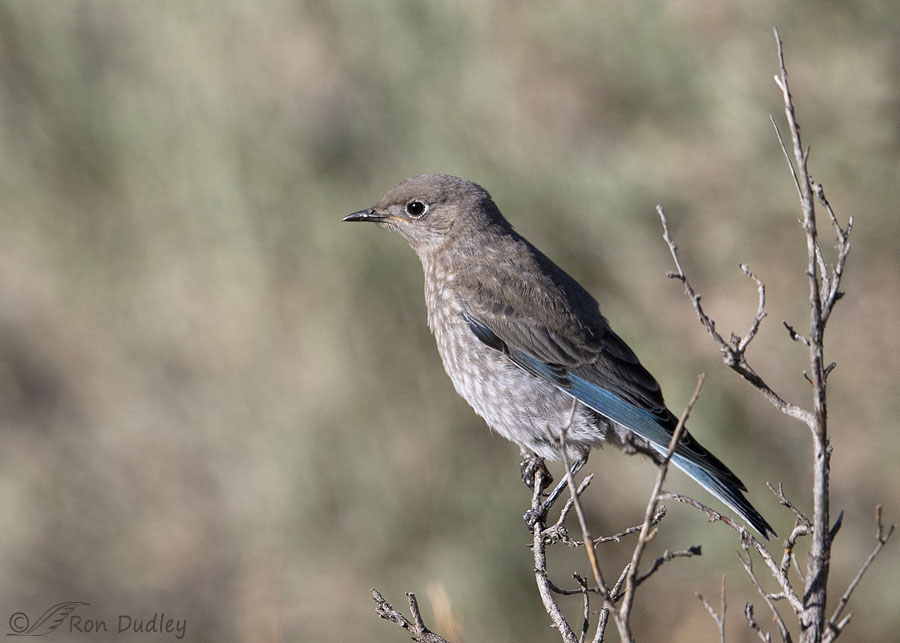
1/2500, f/6.3, ISO 500, Canon 7D Mark II, Canon EF 500mm f/4L IS II USM + EF 1.4 III Extender, not baited, set up or called in
Three days ago while slowly cruising a dirt road in the mountains I encountered a male Mountain Bluebird on a far-off sagebrush (this isn’t him). I thought he was too distant for quality photos but I stopped to watch him on the chance he’d come in closer. It soon became apparent that he had 4-5 fairly recent fledglings in tow and the entire tribe was badgering him for food.
This is one of those hungry juveniles anticipating a meal.
1/3200, f/6.3, ISO 500, Canon 7D Mark II, Canon EF 500mm f/4L IS II USM + EF 1.4 III Extender, not baited, set up or called in
Eventually all of them came in closer to the road as they followed the foraging adult.
Notice how clearly the signature gape of a young bird can be seen in these first three photos.
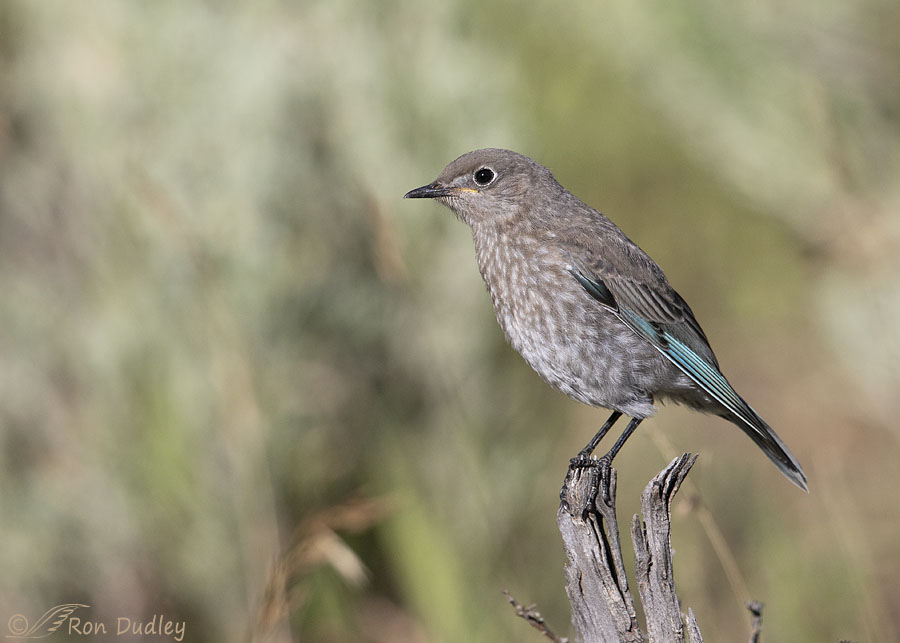
1/3200, f/6.3, ISO 500, Canon 7D Mark II, Canon EF 500mm f/4L IS II USM + EF 1.4 III Extender, not baited, set up or called in
Here’s another youngster perched on an old sage stump.
Occasionally the juveniles appeared to be hunting for insects on their own but I had the distinct impression they were usually unsuccessful at their tender age. Mostly they just followed the male around as he foraged for them.
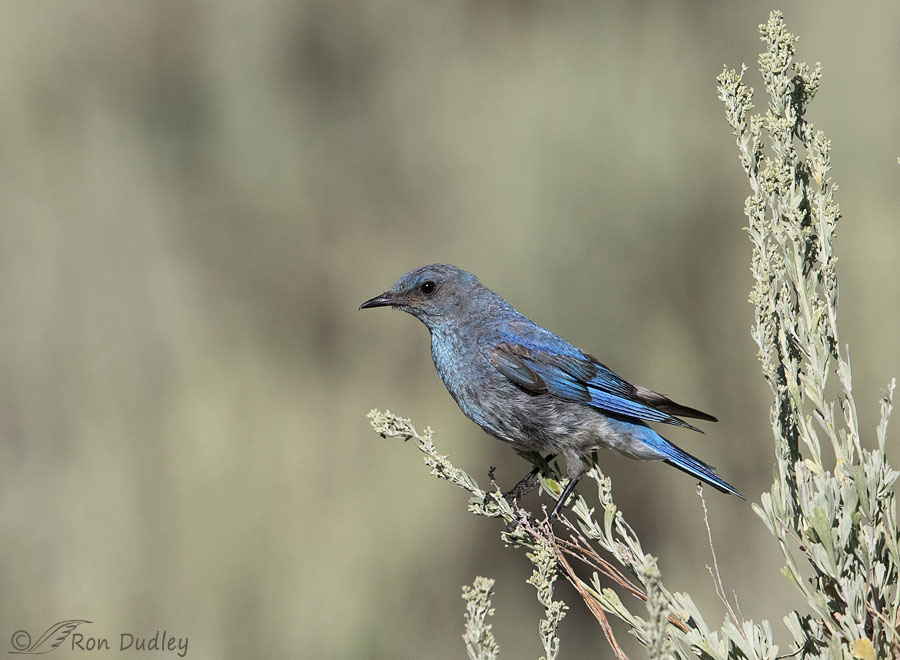
1/5000, f/6.3, ISO 500, Canon 7D Mark II, Canon EF 500mm f/4L IS II USM + EF 1.4 III Extender, not baited, set up or called in
This is the hard working male parent. He’s pretty scruffy looking after the rigors of raising at least four chicks and he may also be molting but he also appears to be ‘wearing to dark’. He’s lost that almost uniform soft blue appearance and now shows splotchy grays and blacks.
I’ve documented and explained ‘wearing to dark’ in some detail in a previous post so I won’t do it again here but if you have the interest here’s a link to that post. If you follow the link I suggest you read Dan Gleason’s interesting and very enlightening comment about ‘wearing to dark’ in other species, including starlings and crossbills.
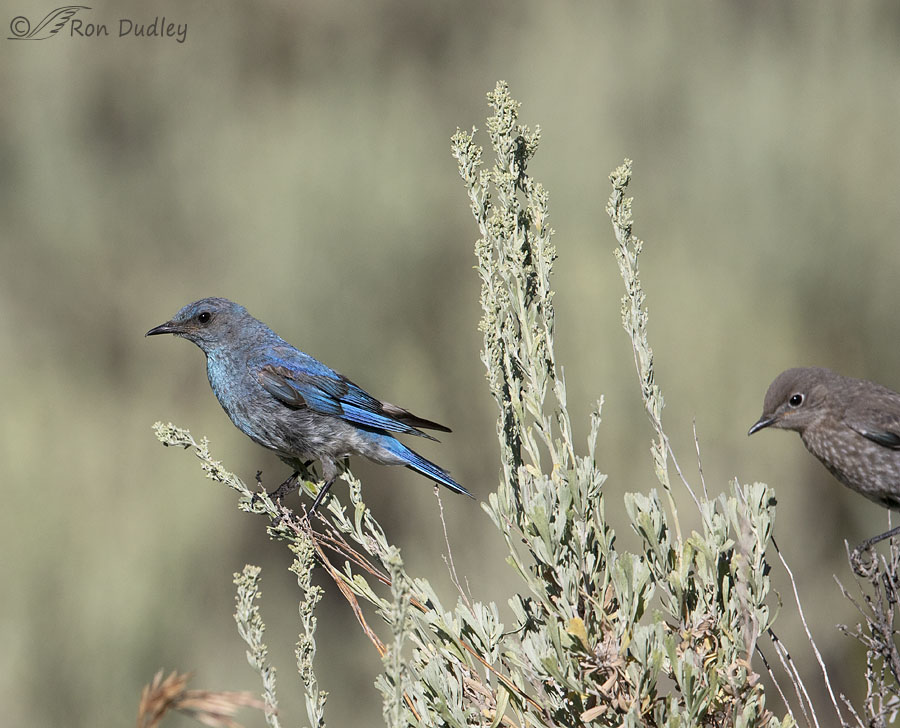
For some perspective on the relationship between the adult male and the juveniles here’s a different crop of the previous photo.
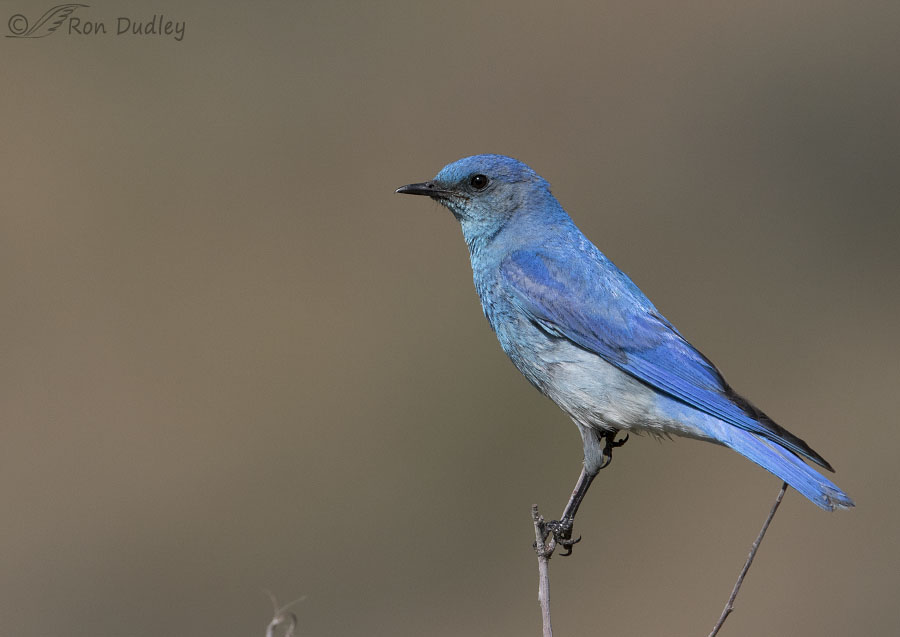
This is what an adult male Mountain Bluebird in breeding plumage looks like before he’s become worn to dark. The contrast is quite dramatic.
I don’t remember seeing the adult female and I never did get any photos of the male actually feeding one of the juveniles. Since the youngsters were almost constantly following the foraging male rather than staying in one place and waiting to be fed that type of shot was harder to get than one might think.
Ron


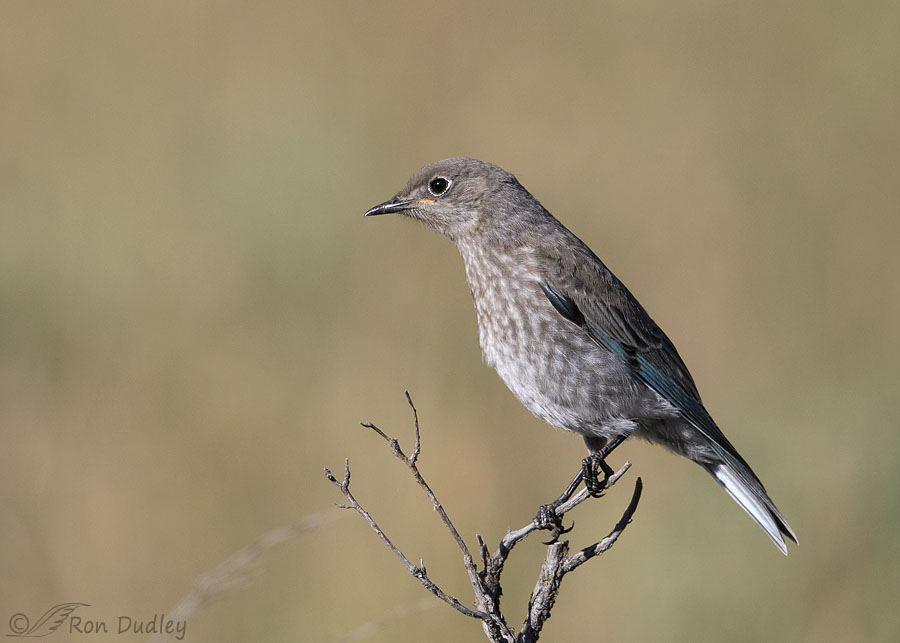
Enjoyed the photos a great deal and found the discussions about “gape” and “wearing to dark” to be quite educational. You have a great blog with wonderful and interesting readers that adds interest every single day. Glad you are keeping up your good work for us all. Thank you.
Very informative posts both present and past. I’ve seen the Mountain Bluebird in eastern Washington, but only from afar, so thanks for the closeups,
So there’s no gap in the gape and wearing to dark has nothing to do with the time of day. Like so many others, I learn from your postings every morning.
Good. Thanks, Dan.
Welp, apparently I’ve been wearing to dark for years, as almost all my “feathers” are grey (and pretty disheveled). 😉
Ron, thank you for an intimate look at this family. Dan, thank you for more fascinating information about birds.
Marty, I guess I’ve been wearing to light. My bald head is lighter than my hair used to be…
My husband would have to agree with you on that one. He’s fortunate that Patrick Stewart is one of my favorite actors. 😉
“Wearing to dark” makes sense if you understand something about how feathers are constructed. The dark color is caused by the melanin pigment in the feathers. The bird actually produces two kinds of melanin: phaeomelanin, producing some colors like the rusty-red of a Red-tailed Hawk, and eumalanin, producing dark colors like black and dark brown. Eumelanin is composed of larber particles. The melanin is incorporated into the feather as it develops. Large amounts of eumelanin stimulate the production of more keratin which makes a slightly thicker and stronger feather. So black feathers are much more resistant to wear and breakage and they are then more resistant to keratin-digesting bacteria, feather lice and other chewing parasites. Note that all woodpeckers have dark tails, which wear less easily when used as a prop against a tree trunk. Friction against the air also causes wear. The flight feathers of most birds, especially long-distance migrants, are dark so they remain strong and mostly intact for migration. American White Pelicans and Snow Geese, are two examples. Egrets are white but they are not long-distance migrants and migrate in short hops, not one long trip. Those all white hummingbirds you often see on the internet are usually doomed to live only a year. The friction against the air caused wear and hummingbirds spend most of their time in the air. So much wear is caused that these birds are usually flightless or nearly so before reaching their first full molt. Without flight, a hummingbird cannot survive. The same is true for swifts, frigatebirds and other birds that spend most of their waking hours in the air. Black in the skin is a different issue, but also caused by melanin. There are almost no studies about skin pigmentation in birds except those that have bare patches exposed, like the head of a Turkey Vulture, etc. We know that some birds have black skin but often only on portions of the body or sometimes seasonally. A Northern Cardinal, for example has black skin on its head during the time of molt. There is some specilation about dark skin but very little research has been done to fully understand the function and which birds have it. A higher percentage of birds have dark skin in equatorial regions but certainly not all. A huge gap in our knowledge and a fresh area of research for anyone wishing to pursue it.
Thank you for this fascinating addition to Ron’s post.
Fascinating stuff, Dan. I’d hoped you’d jump in on this again. Thanks for doing so.
I will chime in with another appreciation for your additions about feathers, Ron. Really fascinating and new to me. And Ron, the bluebird male in the last photo is so spectacular! One flew and turned in front of my car this afternoon, then flew off…it was a very welcome surprise.
Thanks very much, Mary.
Thank you and Dan for refreshing my memory (an essential too often). I think my memory has worn to dark, and wonder whether a complete moult would help.
Having seen how insistent young ‘uns can be (whatever the species) I can only imagine (in horror) the work in bringing up four siblings.
Yet another fascinating start to the day. Mega thanks.
EC, if you try memory molt let me know how it works for you. If you remember…
EC, I love you and I suffer from the same affliction! Would that a molt were possible, but again, that’s another indication that we’re a lesser species 😉
Another excellent post, Ron! My yard is like KinderCare these days- full of begging juvenile Flickers, Eurasian Tree Sparrows, Brown Thrashers and Eastern Bluebirds. All of the adults look shopworn. The juvenile Bluebirds have learned that if they sit on top of the Bluebird feeder, they get fed faster than if they sit in the dogwood. The top of that feeder is valuable real estate! Thanks for the link to the previous post- the refresher course is much appreciated!
I’m so jealous of your yard birds, Diane!
My first thought of the last two pictures…. before and after kids 😳❗️
A beautiful blue bird❗️
Enjoy your day
Yup, that explains it!
Really interesting info, Ron, including the link and Dan’s comment back in 2016 (which I somehow managed to miss). I am now thinking that, on some of my “shabbier” days, I will simply consider myself as “wearing to dark” — an elegant turn of phrase for a less-than-elegant appearance. Though Mr. Mountain Bluebird is still pretty eye-catching in my book!
Your second to last sentence brought a big smile, Chris. That’s probably a strategy I should consider using…
So Beautiful! Even the juveniles have a subtle beauty.
I couldn’t agree more, April.
The wear-to-black discussion is fascinating. Yes, I’m easily amused, but this is a biggie! It leads me to the question of where sun beaching factors into this phenomenon? Wear to black is evident during “my*” redtail’s molt, but only occasionally when when she’s having what I call a bad feather day. Then, she preens and it’s not that visible anymore. Plus, those smaller body feathers grow pretty quickly so that they’re replaced in short order. So there’s that thing where you learn something new which opens up new questions again. I love it when that happens! 🙂
And Everett Sanborn, we’re all amateurs here! There’s always something new to learn and explore with birds! And you KNOW my aversion to using the words always and never! But it this case, always fits perfectly!
*Mariah is no more “mine” than the air I breathe, but there’s a language failure involved here.
Laura, I suspect that ‘wearing to dark’ and bleaching are constantly working against each other. Seems to me it’s the part of the feather that wears away fastest that is most prone to bleaching. Make sense? Or not….
Ron experts have told me that the white is the weakest color and that it wears away first. Conversely, black is the strongest, so I guess that figures in here, too.
Dan Gleason makes that same point in his comment today.
Having to look up new words is part of the pleasure of your posts, and it was “gape” this time. The shot of the juvenile close behind the male is a winner, and I think I may like the latter’s “wearing to black” look even more than his breeding plumage.
Cathy, I probably should have defined ‘gape’ in my text but I did so in my response to Arwen’s question in her comment below.
Thanks for the link on “wearing to dark”, and like Everett and Arwen, I was
unfamiliar with the term “gape”– I was expecting to see a wide-open begging
mouth ! I learn something new every day from Feathered Photography.
“I learn something new every day from Feathered Photography”
I often do too. Thanks, Kris.
I just want to thank you for all of your wonderful posts. I don’t comment much, but for the last couple of years the very first thing I do in the morning is pull up your site and enjoy the beautiful pictures and interesting observations. I am a relatively new birder and I have learned a lot. In these unsettling times your site has been a small beacon of normalcy, education and a reminder that there are good people out in the world. Thank you.
Your comment gave me the warm fuzzies, Kim. Thanks very much.
I second your notion, Kim — this is a great place to enjoy both birds & people!
Gorgeous shots!
Thanks, Jean.
Fun and interesting! The yellow gape is a tell tale sign of a juvenile for sure.. The explanation of “wearing to dark” is both logical and interesting – wonder if it also helps them “blend in” a bit more as seasons change?
“wonder if it also helps them “blend in” a bit more as seasons change?”
Could be, Judy. In many species males in breeding plumage are far from inconspicuous.
Nice photos Ron. Although 82 I still consider myself an amateur birder so I’m not familiar with the gape nor the expression wearing to dark. I don’t have any Mountain Bluebird photos, but checked my Western Bluebird photos and did see the gape on the juveniles, but was not very visible on the adults. Following the Western Bluebirds this spring I often saw them feeding the fledglings, but never got a shot of them feeding the juveniles.
“but never got a shot of them feeding the juveniles”
Everett, that type of shot is a tall order in bluebirds after the youngsters have fledged.
By the way, yesterday I received the newspaper article you sent me. Thank you.
I’m not seeing the gape. What am I missing? I enjoy seeing these birds. Pretty.
“I’m not seeing the gape. What am I missing?”
Arwen, it’s the yellow extension of the mouth between the base of the bill and the bottom of the eye. It can be seen on the youngsters but not on the adult.
Ahhhh! Thank you.